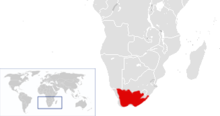
Back Kwagga Afrikaans Equus quagga quagga AN كواغة Arabic Kvaqqa Azerbaijani Квага Byelorussian Куага Bulgarian Quaga Catalan Equus quagga quagga CEB Zebra kvaga Czech Квагга CV
| Quagga Temporal range: Calabrian (stage) to Holocene
| |
|---|---|

| |
| A quagga mare at the London Zoo in 1870; this is the only specimen photographed alive | |
| Scientific classification | |
| Domain: | Eukaryota |
| Kingdom: | Animalia |
| Phylum: | Chordata |
| Class: | Mammalia |
| Order: | Perissodactyla |
| Family: | Equidae |
| Genus: | Equus |
| Species: | |
| Subspecies: | †E. q. quagga
|
| Trinomial name | |
| †Equus quagga quagga (Boddaert, 1785)
| |

| |
| Former range in red | |
| Synonyms | |
|
List
| |
The quagga (/ˈkwɑːxɑː/ or /ˈkwæɡə/)[2][3] (Equus quagga quagga) is an extinct subspecies of the plains zebra that was endemic to South Africa until it was hunted to extinction in the late 19th century. It was long thought to be a distinct species, but early genetic studies have supported it being a subspecies of plains zebra. A more recent study suggested that it was the southernmost cline or ecotype of the species.
The quagga is believed to have been around 257 cm (8 ft 5 in) long and 125–135 cm (4 ft 1 in – 4 ft 5 in) tall at the shoulders. It was distinguished from other zebras by its limited pattern of primarily brown and white stripes, mainly on the front part of the body. The rear was brown and without stripes, and appeared more horse-like. The distribution of stripes varied considerably between individuals. Little is known about the quagga's behaviour, but it may have gathered into herds of 30–50. Quaggas were said to be wild and lively, yet were also considered more docile than the related Burchell's zebra. They were once found in great numbers in the Karoo of Cape Province and the southern part of the Orange Free State in South Africa.
After the European settlement of South Africa began, the quagga was extensively hunted, as it competed with domesticated animals for forage. Some were taken to zoos in Europe, but breeding programmes were unsuccessful. The last wild population lived in the Orange Free State; the quagga was extinct in the wild by 1878. The last captive specimen died in Amsterdam on 12 August 1883. Only one quagga was ever photographed alive, and only 23 skins exist today. In 1984, the quagga was the first extinct animal whose DNA was analysed. The Quagga Project is trying to recreate the phenotype of hair coat pattern by selectively breeding the genetically closest subspecies, which is Burchell's zebra.
- ^ Hack, M.A.; East, R.; Rubenstein, D.I. (2008). "Equus quagga ssp. quagga". IUCN Red List of Threatened Species. 2008: e.T7957A12876306. doi:10.2305/IUCN.UK.2008.RLTS.T7957A12876306.en. Retrieved 13 November 2021.
- ^ Max, D. T. (1 January 2006). "Can You Revive an Extinct Animal?". The New York Times. Retrieved 3 March 2014.
- ^ "Oxford Dictionaries". Oxford University Press. Archived from the original on 18 August 2012. Retrieved 13 August 2014.
